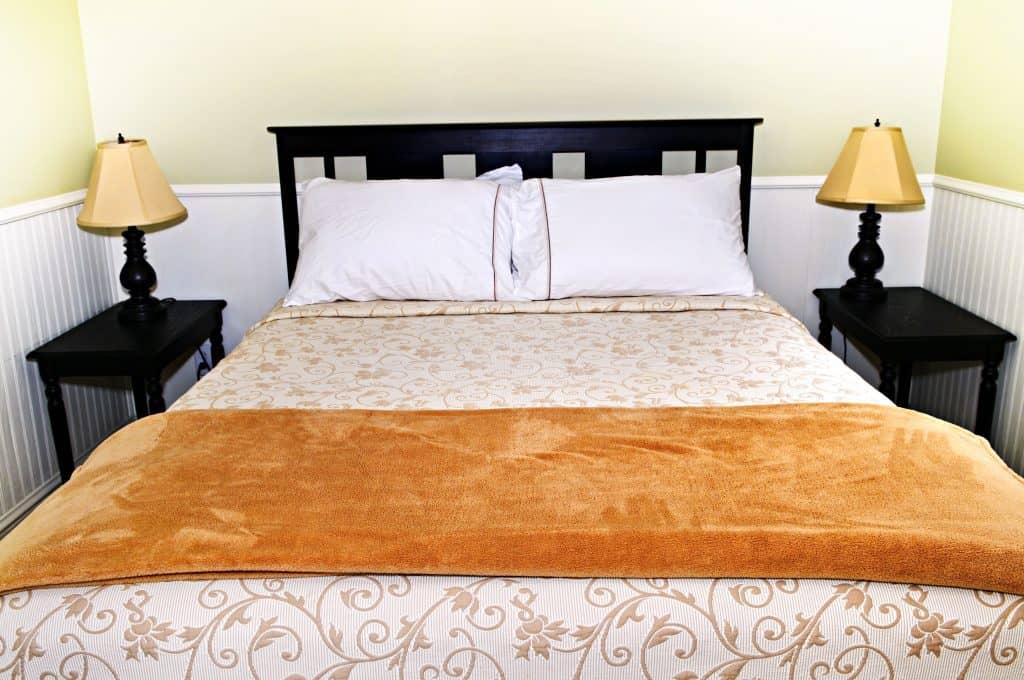
Most of the time, Wainscoting does make a room feel smaller. But it highly depends on the height and the color of the wainscoting.
Higher wainscoting, particularly if the ceilings are low, will make the rooms feel smaller. Moreover, dark-colored wainscoting will make the rooms feel smaller. If you want to use wainscoting to make the rooms feel larger, you should go for shorter ones with lighter colors.
Where should the wainscoting go?
You can use wainscoting to make any room appear more elegant, larger or smaller – it depends on your needs. Even though its main purpose is to protect the lower parts of a wall, most people use it to decorate their homes.
The height of wainscoting ranges between 3 and 5 feet – depending on the needed appearance. People generally install wainscots between the chair rail and baseboard. For example, if your dining room has a narrow window, taller wainscoting will make the window appear larger, bring the ceiling down and make the room appear shorter. The appearance might be great in rooms that have a small table and lots of space.
Wainscoting that is very close to the ceiling will make the ceiling appear lower. People who have chandeliers in their dining rooms might need to match the height of their wainscoting to the height where their chandelier comes down to make their rooms look larger.
Wainscoting styles
Wainscoting offers numerous styles. Beadboard style is among the most popular and comes with grooves. People used to install this form of wainscoting piece after piece, but today the market offers wall length pieces. You can also get raised and flat panel pieces.
Depending on how you plan to arrange the pieces and the painting method you select, you can easily achieve a great appearance. To make interesting pinstripe patterns in a dining room, you will have to paint the wainscoting on the alternating grooves. Paint patterns of large stripes on a single piece and then strip paint the grooves. Depending on the decoration you choose, you will be able to provide your rooms with an elegant feel.
Wood wainscoting
To provide your rooms with an instant personality and protect the surfaces, you will have to select one of the following wainscoting styles.
Raised panels
Raised panels are the most traditional wainscoting style and go back to the colonial days. To make the decorative raise, a designer has to bevel all the sides of the panels. The commonest height is usually 30-40 inches and can be adapted for high ceiling spaces with an addition of center rails to make two rows of the panels. The stiles, rails, and panels fit together in a similar way to that of the traditional flat panel assemblies. Bottom rails double as baseboards.
Flat panels
Recessed flat panels feature simple clean lines that are more popular in mission styles and art and craft. The basic parts start at the floor with a baseboard that can be a plain piece made of panel frame followed by frame pieces (stiles) and panels, which slip into the grooves cut in the rails and stiles edges. The designers use the top rail to complete the rail panel frames and crown the whole assembly with a cap or chair rail. The less labor-intensive method involves paneling the wall with sheet materials and applying moldings on it.
Overlay panels
Overlaid panels are designed to mimic the appearance of any raised panel wainscoting and allow for elaboration of designs. The overlaid solid wood is usually situated between the stiles and rails of the flat panel and is glued in space to create a surrounding recess. To heighten the effects, the designers apply ogee moldings. Overlaid wood can be deep and more detailed than raised panels for neoclassic appearance. You can apply them to your walls directly with a base molding below, a chair rail above for a faster and easier wainscoting.
Board and batten
The board and batten combination style feature vertical battens and flat panels to emphasize a Shaker-like simplicity. Traditionally, people use the battens to conceal seams between the used individual boards. Some people install 4-foot wide hardwood veneer plywood panels but the height can rise to over 6 foot. Designers use a wide plate rail to replace the chair rail and to offer a better platform for the decorative objects.
Beadboard
The beadboard design entered the market in the 19th century and involves the cottage and Victorian styles. It is a classic wall covering for the informal spaces like bathrooms, kitchens and back hallways. To fancy it up, designers add rows of raised or flat panels. For a casual and polished appearance, which might work in your bedroom or dining room, you might need to combine flat panels with tongue and groove beadboards. Moreover, you have to keep both the bottom and middle rails flush to the beadboard streamlines face to enhance the overall appearance.
Non-wood wainscoting
Traditionally, people use wood for wainscoting. However, today, they are using other materials, which offer longlasting style. The materials include:
PVC plastic
Smooth paintable extruded PVC beadboards might be perfect for people who want sharp or woodgrain profiles. The plastic never rots or warps.
Embossed metal
If you require something that is completely different, you can fasten the stamped tin you mostly see on ceilings. But to make it less susceptible to denting, you will have to butter its back with joint compound or plaster before you mount the tile on a plywood substrate.
Ceramic Tiles
Four-inch ceramic tiles are the most traditional form of wainscoting and people commonly use them in their bathrooms. Most tilemakers provide profiles that people can use to base and cap moldings. Tile beadboards are the newest and combine classic appearance with water resistance and durability of tiles.
Embossed MDF
32inch x 48inch x 5/8inch sheets featuring contours of raised panels, usually pressed into a surface are also common. The designers fasten them to walls above the base molding and cap them with a chair rail for a great look. However, the styles lack the shadow lines associated with rails, stiles, and panels. Moreover, users cannot adjust the panel widths for specific wall lengths.
Shaped MDF
Shaped MDF is usually covered with factory-primed and hardwood veneer – usually ready for painting. People use MDF for beadboard, stiles, panels, mouldings, and rails. They are more stable than the solid woods and eliminate the problems resulting from contraction and expansion.
Embossed drywall
32inch x 48inch x 5/8inch gypsum boards featuring raised-panel shapes are also common. Apart from sacrificing the verisimilitude, you will forego the protective power of other wainscoting by using the embossed drywall.
The installation tips of wainscoting
The preparation of materials to use
To install wainscoting properly, you have to start with preparation of the wood you intend to use – whether you plan to paint it or to keep it natural. You should also seal it all over its back and front to reduce chances of contraction and expansion, known to crack seams. Finally, you will have to stain or prepaint to eliminate the chances of visible unfinished wood.
Fitting the materials
To start perfectly, you will have to adjust the first few strips to compensate the strip that is out of plumb. Hold the strips tighter against the walls and adjust them until they have leveled. Measure the resulting gap. Starting at the strip that touches your wall, you have to cut lengthwise such that it tapers from the gap to the full width of the strip. The strip has to fit the angle and remain plumb.
Wavy walls
Existing walls might harbor several waves that you have to flatten if you do not want to make the wainscoting untrue. To make a flat nailing plane, you can fasten horizontal furring strips to the wall studs through plaster or drywall. Use shims on isolated spots to fill the left void. To make the chair rail, fasten filler strips.
Uneven floors
Floors feature high and low spots – including when the difference is around 1/8 inches. Therefore, during installation of wainscoting, you will have to avoid similar lengths. Also, you will have to start from the baseboard upwards. Find all the higher spots and mark the level of your chair-rail. To level the baseboard, you will have to shim as needed and use blocks equal to the gap height. Scrub and cut your bottom edge to match the ups-and-downs of your floors.
Coming up with a perfect finish
If your chair rail is wider than your door casing or sops outside a corner, you will have to use a return to finish the exposed ends – small wedges that return the moldings back to the walls. End the chair rails with 45-degree cuts – just as you end the outside corners. To make a wedge, make 90-degree cuts where the miter starts. Remember that dark colors will make your room appear smaller.
Conclusion
Install white raised board wainscoting and paint their framed grooves black. That way, you will make a framed appearance. You can also use a dark color as the main as your main paint color to make your room smaller – white color will add elegance to any room and make it appear larger. The white color is more suitable for people with dark dining tables.
To double up your wainscoting, you will need to put two pieces – each on top of the other – to make a paneled appearance. However, that might not work if the space between your ceiling and wainscoting is small. You would end up making your room appear smaller. The design fits perfectly in rooms with higher ceilings. If your room is smaller, get the shortest wainscoting possible.

